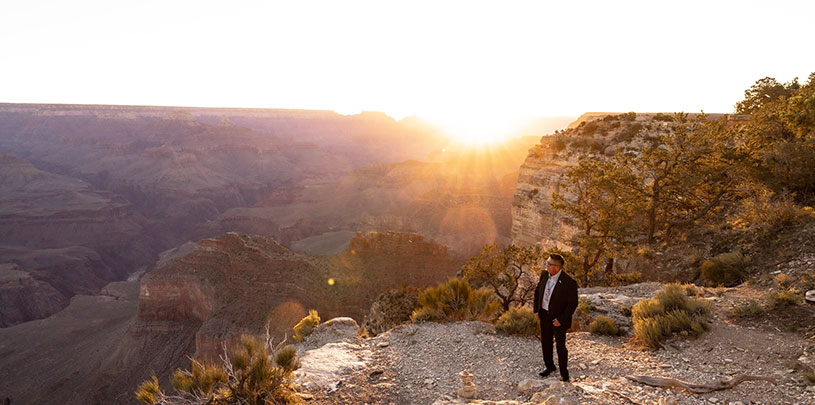
 by Amber Reimondo, Energy Director
by Amber Reimondo, Energy Director
Baaj Nwaavjo I’tah Kukveni – Ancestral Footprints of the Grand Canyon National Monument protects nearly 1 million acres of Native American tribes’ ancestral homelands north and south of the Grand Canyon. In its sprawling forests and grasslands lie thousands of cultural resources and archaeological sites—evidence of Native peoples’ continued presence here since time immemorial.
Though many tribes’ reservations are some distance from the monument today, all maintain strong cultural connections to the lands and waters that make up Baaj Nwaavjo I’tah Kukveni.
Here, we catch up with Timothy Nuvangyaoma, the chairman of the Hopi Tribe from the village of Musangnuvi on Second Mesa, who shares the significance of the monument designation, Hopi cultural connections to the Grand Canyon region, and the importance of water in this arid landscape.
 Hopi Chairman Timothy Nuvangyaoma soaks in a Grand Canyon sunrise. RAYMOND CHEE
Hopi Chairman Timothy Nuvangyaoma soaks in a Grand Canyon sunrise. RAYMOND CHEE
"Our connection as Hopis goes back to the beginning of time. The Grand Canyon is a place of emergence for the Hopi people and the clans that eventually migrated through all four corners of this world, Tuuwaqatsi. There are many cultural and religious sites that are still very much alive today.
It holds a place that we call Öngtuvqa, which is a salt mine area that has a really strong cultural significance. And several other tribes use that resource for their own ceremonial doings. Even today, there’s a certain group of Hopi men with privileged knowledge that make rigorous pilgrimages to some of these sacred sites to make offerings and blessings, for not only Hopi, but for the entire world and everybody that inhabits it, including all the animals.
The establishment of the monument tells the world that we are going to continue fighting to protect areas of cultural and traditional significance, and the natural resources that live and thrive in the canyon. It's an important step in the right direction to protect this area for generations to come."
"The natural resources that are inside and outside the Grand Canyon are important for not only Hopi, but Native Americans. What is out here benefits all people in the form of medicines and in the form of food, Neeveni. We collect a lot of this food that helps feed our families.
For us, we have several areas outside of the actual Grand Canyon. There’s a place called Pivanmuru, which is an area where Hopi tobacco grows. I’m Tobacco Clan, so that is really important.
We harvest animals in sensitive ways for cultural uses. There’s a place called the Yöngösona trail, where turtles thrive — that’s also used for ceremonial purposes.
We’ve got the eagles, the condors, the rabbits, deer — a number of different species that help provide back into the world with their own gift of life. But it’s never taken in vain; it’s not a sport for us. There’s a lot of preparation and offerings."
What’s the cultural significance of water in the Grand Canyon region?
 Baaj Nwaavjo I'tah Kukveni protects a critical portion of the Colorado River's watershed, including groundwater that feeds springs in the Grand Canyon. AMY S. MARTIN
Baaj Nwaavjo I'tah Kukveni protects a critical portion of the Colorado River's watershed, including groundwater that feeds springs in the Grand Canyon. AMY S. MARTIN
"Water is life. I think it’s become cliché, but it really is. It’s really our lifeblood that provides for us and every living thing.
People ask, 'Why would the Hopi move out here to live in such an arid landscape to be dry farmers?'
But Hopis have been here since time immemorial. And the area we now call home is work. It's hard work. And that's what the Hopis understood. When that area became our homeland, we didn't know was how rich it was with the aquifer underneath that sustains life.
I've heard this from another elder — our place of emergence [in the canyon] is our heart. And underneath that we have water, living water, the Colorado River. And like a heart, it pumps. It keeps the world alive. In a human body, that heart sends blood through arteries to the entire body to keep it alive. That's the same concept with the heartbeat in the Grand Canyon. There's so many underground tributaries and ways that water flows in its own arteries that feed this entire world.
So when I look at where we're at, I think it's beautiful. It's a little tough at times. But Hopi and our connection to water is beyond what I can explain in words. That's why our ceremonies, our prayers, are centered around rain and bringing in the moisture, to help sustain life and provide for our crops.
Again, water is life. And the meaning of it is just beyond words. But we'll continue to be Hopi, and we will continue to pray that moisture continues to help sustain life."
"I hope tourists learn that this area has been inhabited by tribes since time immemorial and learn in a respectful way about the significance of the cultural sites.
I’d like them to take a way that sense of belonging — that positive energy that is here with every living being. It’s a feeling you just have to experience yourself. Being a small, minute being on such a beautiful canvas of life. I want people to experience this beauty in a respectful way and take it back to where they come from. So that we can care for lands and be better stewards, all of us together."
80% of Arizona voters support Baaj Nwaavjo I'tah Kukveni National Monument, according to a new poll.
Read MoreThe Colorado River below Glen Canyon Dam is heating up. Find out why.
Read MoreGroundwater pumping at a uranium mine near the Grand Canyon will affect the canyon's springs, scientists says.
Read More